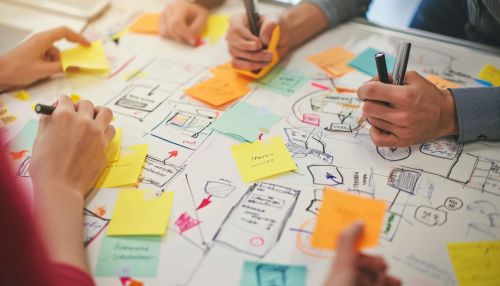Design Thinking
Overview
Design Thinking is a non-linear, iterative process that teams use to understand users, challenge assumptions, redefine problems and create innovative solutions to prototype and test. Involving five phases—Empathize, Define, Ideate, Prototype and Test—it is most useful to tackle problems that are ill-defined or unknown.
History
The concept of design as a "way of thinking" in the sciences can be traced to Herbert A. Simon's 1969 book "The Sciences of the Artificial," and in design engineering to Robert McKim's 1973 book "Experiences in Visual Thinking." Peter Rowe's 1987 book "Design Thinking," which described methods and approaches used by architects and urban planners, was a significant early usage of the term in the design research literature.
Process
Design Thinking revolves around a deep interest in developing an understanding of the people for whom we're designing products or services. It helps us observe and develop empathy with the target user. Design Thinking helps us in the process of questioning: questioning the problem, questioning the assumptions, and questioning the implications.
Empathize
Empathy is crucial to a human-centered design process such as Design Thinking, and empathy allows design thinkers to set aside their own assumptions about the world in order to gain insight into users and their needs.
Define
In the Define stage, we put together the information we have created and gathered during the Empathize stage. We will analyze our observations and synthesize them in order to define the core problems that we have identified up to this point.
Ideate
During the third stage of the Design Thinking process, designers are ready to start generating ideas. The solid background of knowledge from the first two phases means you can start to “think outside the box”, look for alternative ways to view the problem and identify innovative solutions to the problem statement you’ve created.
Prototype
This is the experimental phase. The aim is to identify the best possible solution for each of the problems identified during the first three stages. The solutions are implemented within the prototypes, and, one by one, they are investigated and either accepted, improved and re-examined, or rejected on the basis of the users’ experiences.
Test
Designers or evaluators rigorously test the complete product using the best solutions identified in the prototyping phase. This is the final phase of the model but, in an iterative process such as design thinking, the results generated are often used to redefine one or more further problems.
Application
Design Thinking is designed to be a quick, iterative process. The idea is that, the faster we fail, the faster we'll get to the solution. Design Thinking is not just for designers but for creative, curious people who are always willing to learn and iterate their ideas.
See Also
User Experience Design Human-centered Design Innovation Problem Solving Prototyping


